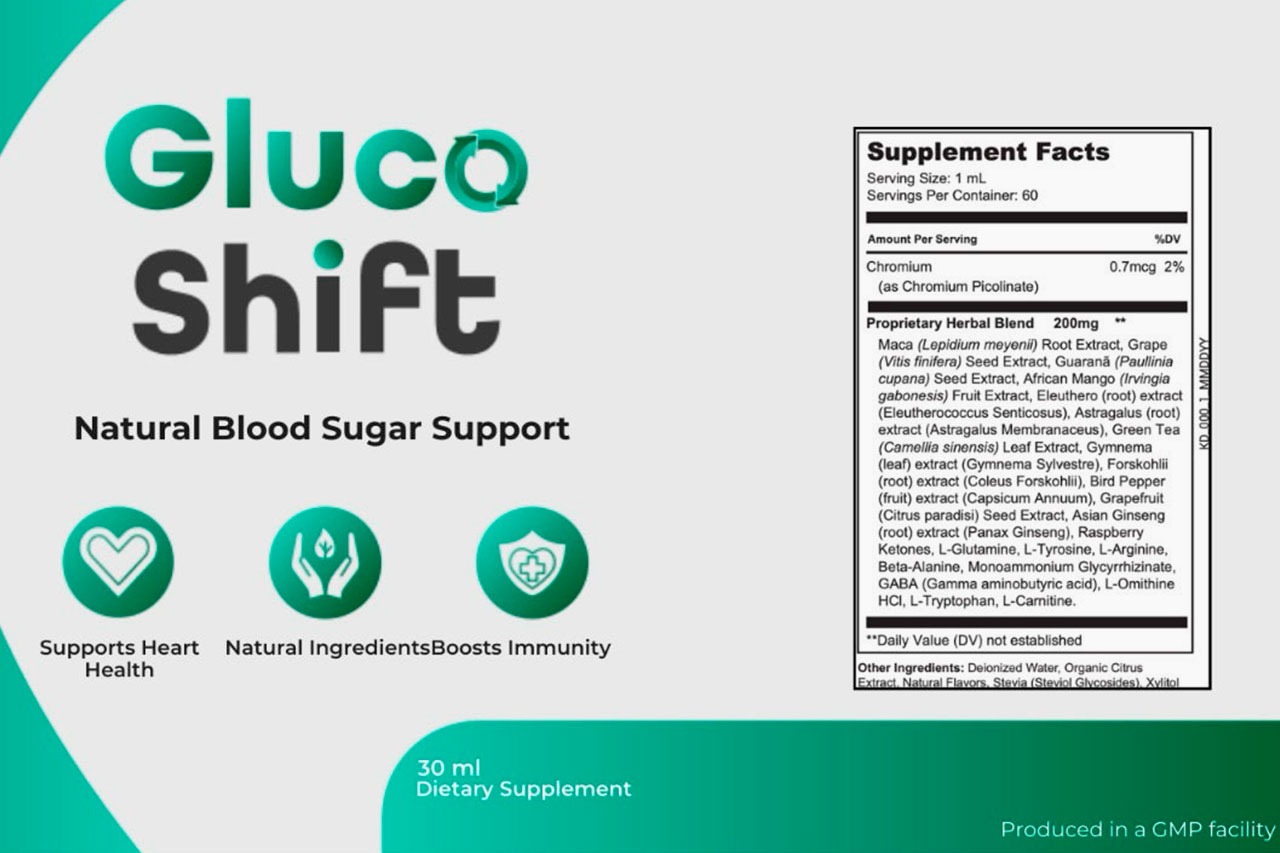
How often do you alternate between having brain fog, peak energy levels, and complete deflation? Are you struggling to keep your productivity levels and blood sugar levels in check? Fluctuating blood sugar levels have long been a debated topic, with metformin making a significant difference in the lives of those with type 2 diabetes.
Since then, several dietary supplements have come and gone. As our editorial team continues to navigate this space (who wouldn’t, given the prevalence of glucose-related health conditions), one team’s strategy caught our attention. Just as the gut-brain connection was initially dismissed but is now gradually being accepted, another overlooked connection is the “gut-diabetes connection.”
What does this even mean? Here’s a complete picture of Gluco Shift.
What is Gluco Shift?
Gluco Shift is an all-natural blood sugar support designed to maintain normal blood sugar levels, promote healthy heart function, and boost immunity. It contains a wide range of plants, herbs, and berries. The creators emphasized that their strategy entailed looking closely at the “gut-diabetes” connection.
Our editorial team was taken aback for a second, as most people are familiar with the concept of the gut-brain connection, but not this one. They argue that as people go about their daily activities, they are likely to breathe, eat, and drink beverages, all of which are likely contaminated with environmental and other toxins.
A 2020 Frontiers study shows that toxin exposure, mainly when it accumulates over time, can disrupt normal bodily functions, including insulin receptors. Whether this is why most people are diagnosed with diabetes or experience fluctuating blood sugar levels isn’t the debate here. Instead, individuals should consider their direct impact on specific areas that could be reversed.
As the creators maintain, Gluco Shift is one possible avenue for correcting such disruptions.
Let's explore the gut-diabetes connection to understand what Gluco Shift might achieve fully.
Get started today and see the difference Gluco Shift can make!
How does Gluco Shift work?
Earlier, we mentioned that Gluco Shift aims to take advantage of the gut-diabetes connection. While there is no formal definition of this connection, studies on the relationship between the gut and diabetes have been emerging for some time. One study, as described in one source [1], looked at the effect that a person’s gut microbiome composition may have on the risk of developing type 2 diabetes. The scientists specifically analyzed people with type 2 diabetes composition, scanning them for bacteria, fungi, and viruses.
By the end, they found a species common to the diabetic participants, some of which had never been reported. For instance, one such strain is the gut bacteria Prevotella copri, which existing studies have linked to increased production of branched-chain amino acids and, consequently, a higher risk of obesity and type 2 diabetes. Additionally, they found that bacteriophages, or “viruses that infect bacteria,” can alter bacterial function in the gut.
Undoubtedly, more research is still needed on this front. However, one thing is certain, according to one of the quoted scientists. In particular, they underscored that “changes to the microbiome may happen first, and diabetes develops later, not the other way around.” It is important to note that this study looked at people’s microbiomes simultaneously. Conducting a longitudinal study to see how the microbiome changes over time might be more beneficial.
A systematic review [2] examining the role of the gut microbiome in diabetes and treating a leaky gut revealed some of the effects of changes to our gut’s bacterial composition. These include alterations in short-chain fatty acids (improves insulin sensitivity), bile acid metabolism (releases GLP-1 hormone), lipopolysaccharides (high levels lower insulin sensitivity), and energy producers (essential for glucose uptake).
Considering what we’ve learned up to this point, individuals need to consider two things. First, it might be worthwhile to reflect on dietary and lifestyle choices, as they alone contribute significantly to the gut microbiome and toxins.
Second, it is imperative to find ways to correct the damage done. Does Gluco Shift truly meet the second requirement? The only way to find out is by looking into the ingredients.

What ingredients are inside Gluco Shift?
A single Gluco Shift (1 mL) serving consists of a 200-mg proprietary blend of ingredients. Central to this formula are the following:
Gymnema Sylvestre
Gymnema Sylvestre [3] is an herb renowned for a bioactive compound called gymnemic acid. This compound has been demonstrated to lower blood sugar, increase insulin production, suppress the taste of sugar (thereby eliminating cravings), and possibly improve heart health by preventing fat and sugar absorption. One study [4] that looked at the effects of Gymnema Sylvestre on streptozotocin-induced hyperglycemia in type 2 DM rats found that the herb might “reversibly restore gut microbiota diversities” while increasing bacteroidetes abundance.
It also interfered with glucose metabolism processes, altered the abundance of Clostridium, Lactobacillus, and the Bacteroide family of strains, and promoted levels of acetic acid and short-chain fatty acids in their feces. This preliminary study led the researchers to conclude that Gymnema Sylvestre might help improve blood sugar levels by way of gut health regulation. Another animal study [5] also confirmed these findings, adding that gymneic acid might regulate high-fat diet-induced gut microbiota disturbances and gut barrier function impairment, possibly helping erase imbalances in gut bacteria.
Gluco Shift Is On Sale Now For A Limited Time!
Banaba Leaves
Banaba leaves [6], from the Lagerstroemia speciosa tree native to Southeast Asia, have a history of treating diarrhea, pain, and blood sugar fluctuations. Of the several uses, science seems to agree that its rich sources of corosolic acid and ellagic acid stand out in the context of lowering blood sugar levels. This is achieved by increasing insulin sensitivity and glucose uptake (activating the glucose transporter type 4 protein) and blocking an enzyme called alpha-glucosidase, which is responsible for digesting carbs. As promising as these findings are, most studies suggest further investigation, as not all study designs reflect different populations.
Intriguingly, banaba leaves also have some role to play in fat loss. Specifically, they have been proven to block adipogenesis and lipogenesis, i.e., two processes that increase fat cell and fat molecule production. Other benefits include lowered blood cholesterol and triglyceride levels, protection against certain bacteria, viruses, and kidney damage, and regulated blood pressure levels.
Bitter Melon
Bitter melon, or Momordica charantia, is a plant that grows predominantly in Asia, South America, the Caribbean, and East Africa, writes one source [7]. In terms of blood sugar levels, studies on bitter melon is said to mimic the effects of insulin (e.g., delivering glucose to cells for energy and blocking the conversion of nutrients to glucose to some extent). While bitter melon is unlikely to serve as a standalone treatment, it might be an exciting support system to alleviate the symptoms of inconsistent blood sugar levels.
A more recent study [8] that examined the effects of bitter melon on Korean prediabetes participants found that it exhibited glucose-lowering effects by blocking glucagon levels. Typically, higher glucagon levels have been linked to higher blood sugar levels. Finally, a study that examined bitter melon closely reported that its rich source of dietary fiber could improve the gut microbiota, at least at the genus level [9].
Cinnamon
Cinnamon [10] is a spice made from the inner bark of the Cinnamon tree. It contains an abundant source of antioxidants, imperative for reducing oxidative stress linked to the risk of developing type 2 diabetes. In people with diabetes, this spice is believed to increase insulin sensitivity, reduce fasting insulin levels, lower hemoglobin A1c (a measure of long-term blood sugar control), and lower the risk of common diabetes complications. These include the risk of heart disease, stroke, high blood pressure, Alzheimer’s disease, and other types of dementia.
A mouse model [11] that investigated the effects of cinnamon essential oil on the gut microbiota found that it alleviated dextran sodium sulfate (DSS)- induced colitis while improving the diversity and richness of the intestinal microbiota and decreasing Helicobacter. The latter has been associated with TLR4 and tumor necrosis factor-alpha, both of which are known contributors to inflammation. Additionally, Helicobacter is believed to lower short-chain fatty acids, which, as mentioned earlier, is imperative for improving insulin sensitivity.
Get Gluco Shift now while it's on sale – limited time only!
Licorice Root
Licorice is a herb that grows in parts of Europe and Asia. Of the different health benefits, licorice has been best known for its effect on blood sugar levels. Specifically, research [12] has proven that the herbal extract form of this ingredient might increase insulin sensitivity and glucose uptake, neutralize free radical damage, reduce oxidative stress, and correct lipid and protein metabolic disorders. These are attributed to five flavonoids and three triterpenoids. That’s not all; the researchers pinpointed the precise signaling pathways: “P13K/Akt, AMPK, AGE-RAGE, MAPK, NF-kB, and NLRP3.”
A more recent research study [13] that investigated the hypoglycemic activity and mechanisms of licorice confirmed the above results, adding that it also has the potential to reshape the gut microbiota at the genus level. This involves decreasing and increasing harmful and good bacteria, respectively. Ultimately, licorice root’s ability to improve blood sugar levels wouldn’t be possible had it not been for its role in positively altering the gut microbiome.
Juniper Berries
The juniper tree (i.e., Juniperus communis) [14] is an evergreen shrub that grows blueberry lookalikes called juniper berries. Aside from the marginal variation in color, juniper berries aren’t as edible as blueberries but offer various health benefits. However, existing 2024 MDPI studies confirm that these berries' high antioxidant content supports blood sugar-lowering processes. On the bright side, juniper berries may inhibit the activity of three bacteria linked to serious infections, which might protect the gut microbiome.
Chromium
Chromium [15] is essential to insulin’s overall function. In particular, it might come in handy for people with diabetes – either due to the absence of insulin or poor use of insulin. Moreover, it might improve HbA1c values, fasting blood sugar levels, weight and fat loss results, and possibly support heart health. Unfortunately, many of these benefits still need to be verified. What surprised our editorial team is the probable link between chromium picolinate [16], the very type found in Gluco Shift, and a healthy gut microbiome.
To be more precise, it improved insulin sensitivity, increased the presence of the sodium-glucose transporter 1 expression (SGLT1) protein crucial for absorbing glucose from the intestines to the bloodstream, altered the gut microbiome composition, and released gastrointestinal peptides.
Don't miss out on this limited-time opportunity to get Gluco Shift!
Cayenne
Cayenne [16] is a hot pepper from the nightshade plant family. Its spicy nature is attributed to its bioactive compound, capsaicin. While several reported health benefits exist, individuals need to be mindful of replicability. In this case, more research is still required. Despite the lack thereof, studies have shown that capsaicin might lower blood levels. Both low- and high-dose capsaicin diets may prevent an increase in fasting blood sugar and insulin tolerance [17]. Once again, this ingredient’s ability to positively influence glucose, according to the same study, has to do with its ability to alter specific bacteria at the genus level.
As such, individuals can anticipate an increase in short-chain fatty acids, regulation of gastrointestinal hormones, and inhibition of pro-inflammatory cytokines. The authors did note that these results should be used with caution, as the study [17] involved a lower caloric intake at the initial stage after consuming capsaicin. Could the decrease in calories have influenced the outcomes? This is something to dwell on.

Further ingredients that either strengthen the Gluco Shift formula or mitigate fluctuations in blood sugar levels are:
- Maca Root [18]: Might boost energy and endurance.
- Grapeseed: May improve heart health and brain function.
- Guarana: May reduce fatigue, improve heart health, and promote weight loss.
- African Mango: Might encourage weight loss, shrink the waist, and support fat burning.
- Eleuthero: Might reduce fatigue and insulin resistance.
- Astragalus: Might improve sugar metabolism and reduce blood sugar levels.
- Green Tea: Might reduce fatigue, support brain function, and reduce fasting blood sugar.
- Forskohlii: Might promote weight and fat loss.
- Grapefruit Seed: Has antimicrobial and antioxidant effects.
- Panax Ginseng [27]: May reduce inflammation, improve brain function, and boost immunity.
- Raspberry Ketones: Might increase the breakdown of fat.
- L-Glutamine [29]: Might support immune, digestive, and brain functions.
- L-Tyrosine [30]: Contributes to the production of various neurotransmitters.
- L-Arginine: Might delay the onset of type 2 diabetes.
- Beta-Alanine: Might boost performance and strength.
- GABA [33]: Produces a calming effect.
- L-Ornithine [34]: May enhance detoxification of ammonia in the liver.
- L-Tryptophan: It might improve sleep, mood, and pain tolerance.
- L-Carnitine: Might promote weight loss and increase brain function.

Frequently Asked Questions (FAQ)
Q. Is Gluco Shift safe?
A. Gluco Shift appears to be safe for two main reasons. First, it was manufactured in an FDA-registered, GMP-certified facility in the United States, a benchmark for supplement providers. Second, it contains relatively low doses of known plants, herbs, and berries. Each serving packs several ingredients for a dosage of 200 mg. So, the risk of unwanted side effects is likely slim. Naturally, consulting a healthcare professional and conducting your research is invaluable.
Q. How should I take the Gluco Shift?
A. Individuals are recommended to take one serving (or two full droppers) twice daily or as directed by a healthcare professional. Pregnant and nursing mothers or people with an existing medication condition will need to get an expert opinion before adding anything new to their routines. Anyone under 18 years old should not be taking Gluco Shift to begin with.
Q. How long do I need to wait for my Gluco Shift shipments?
A. On average, shipments with a final destination to most states in America will have to wait 5 to 7 business days. International shipment is variable, with some receiving their shipments within the first 15 business days and others later.
Visit official website to learn about Gluco Shift >>>
Q. Is Gluco Shift protected by a money-back guarantee?
A. Yes, Gluco Shift has been protected by a 180-day money-back guarantee. This means individuals are given 180 days from the purchase date to try the supplement. If it fails to improve blood sugar readings within the period, all unused tinctures should be eligible for a full purchase price refund. More on what this process entails can be gathered in one of the following ways:
- Email: support@getglucoshift.com.
- Phone: 1 (877) 238-9269
- Return Address: 19655 E 35th Dr. #100, Aurora, CO 80011, USA.
How much does Gluco Shift cost?
Each Gluco Shift tincture contains 30 ml of servings, enough to last a month. In light of this, the creators established the pricing structure like this:
- 1 Gluco Shift bottle: $64.99 each + applicable shipping
- 3 Gluco Shift bottles: $59 each + free U.S. shipping
- 6 Gluco Shift bottles: $49 each + free U.S. shipping

Concluding Remarks
After an extensive look into Gluco Shift, the key takeaway is this: the gut microbiome is the basis of our health. Dysbiosis, or an imbalance in microbial communities, negatively impacts levels of short-chain fatty acids, bile acid metabolism, and energy producers, among others. Insulin receptors’ sensitivity is important for blood glucose management, as they help transport glucose from the bloodstream to cells, tissues, and organs. Does the rationale for the gut-diabetes connection convince our editorial team? More emerging studies are arriving at similar conclusions.
What’s impressive is that many of the ingredients found in this supplement are common in blood glucose supplements. We have learned that many of the same main ingredients in Gluco Shift also alter the diversity and richness of the gut microbiome. Their ability to lower blood sugar levels by activating various pathways is only possible because of their ability to improve the gut. Fascinating, isn’t it?
While the positives are exciting, individuals should remember that these findings are somewhat new and need further investigation. This is especially critical, as more recent studies were conducted on animals, not humans. Second, improving the gut requires gut-friendly nutrients, which individuals should consider getting through food. Solutions like Gluco Shift are just one part of the puzzle; diet and lifestyle choices are equally important.
Lastly, the dosage is quite low given how packed this supplement is. It also doesn’t help that our research focuses on each ingredient’s role individually rather than collectively. Will the outcomes vary accordingly, or will synergy prevail? This is an area that our editorial team encourages everyone to explore, along with their own health with respect to Gluco Shift. To get started with Gluco Shift, visit here>>>.